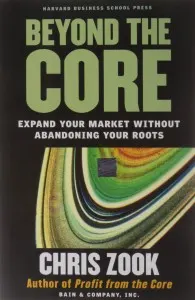Streaming video company Netflix “once desperately offered itself to the now-bankrupt Blockbuster Video for $50 million—and was rejected—is now a profitable $5 billion company growing at about 20 percent per year,” according to the Harvard Business Review.
“Few would have imagined that a company built around the distribution of CDs by mail could, in just a few years, migrate its business model to streaming content on the Internet and eventually to producing its own content, moving Netflix towards being the next-generation equivalent of a television station.”
It’s a remarkable business story.
 Harvard Business School Professor Chris Zook looked at these ideas in his 2004 book, Beyond the Core: Expand Your Market Without Abandoning Your Roots. The book outlines an expansion strategy based on putting together combinations of adjacency moves into areas away from, but related to, the core business, such as new product lines or new channels of distribution.
Harvard Business School Professor Chris Zook looked at these ideas in his 2004 book, Beyond the Core: Expand Your Market Without Abandoning Your Roots. The book outlines an expansion strategy based on putting together combinations of adjacency moves into areas away from, but related to, the core business, such as new product lines or new channels of distribution.
Zook identified “six types of adjacency growth moves: moving your core business to a new geography, serving a new customer segment, entering a new channel of distribution, selling a new set of products for your core customers, integrating new steps along the value chain, and building a new business based on your capabilities.”
His key findings:
“Across the full sample we found that the odds of success were only about twenty percent. Most growth initiatives failed and the reason turned out to be because companies moved too far beyond their core business too fast into areas where they were not skilled (and where others were skilled). What was an ‘adjacency” to one company was the “core” to someone else and companies consistently underestimated how hard competitors would fight to defend their core. The highest odds of success were associated with introducing new products to your own core customers; the lowest odds were associated with building new businesses based on a capability.”
Some questions to answer during your next strategy offsite meeting:
- If a few capabilities are the crown jewels of business, what are our crown jewels?
- What is the state of these capabilities relative to competition? How do we know in a measurable way? Do our customers and employees agree with us? What are we going to do about it?
- What are the new capabilities that we need to add or bring up to world class status? What is the plan to add them and ensure they are world class?
- What are the growth opportunities that these new capabilities will enable in the short term and the long term? Are we investing enough?
